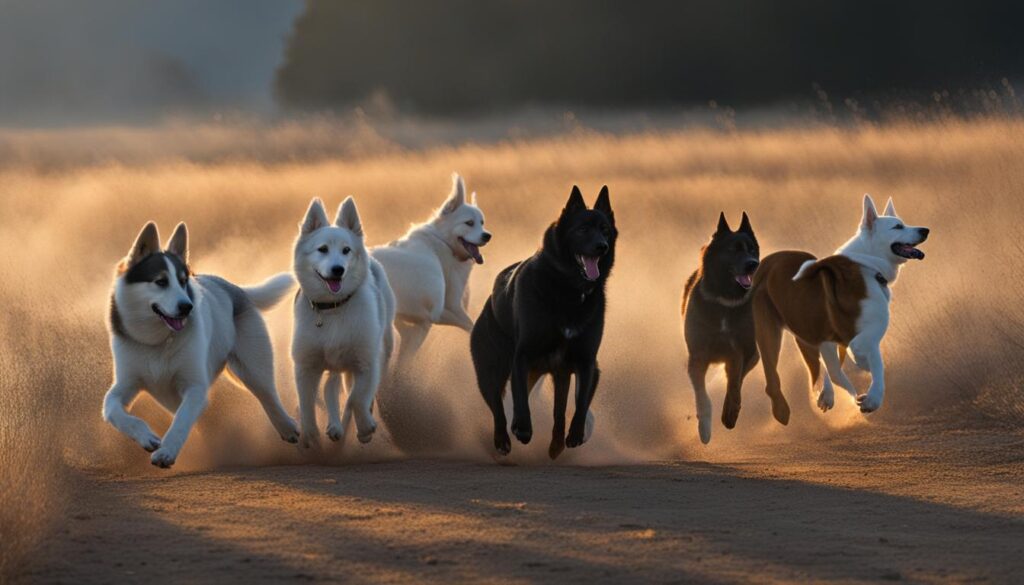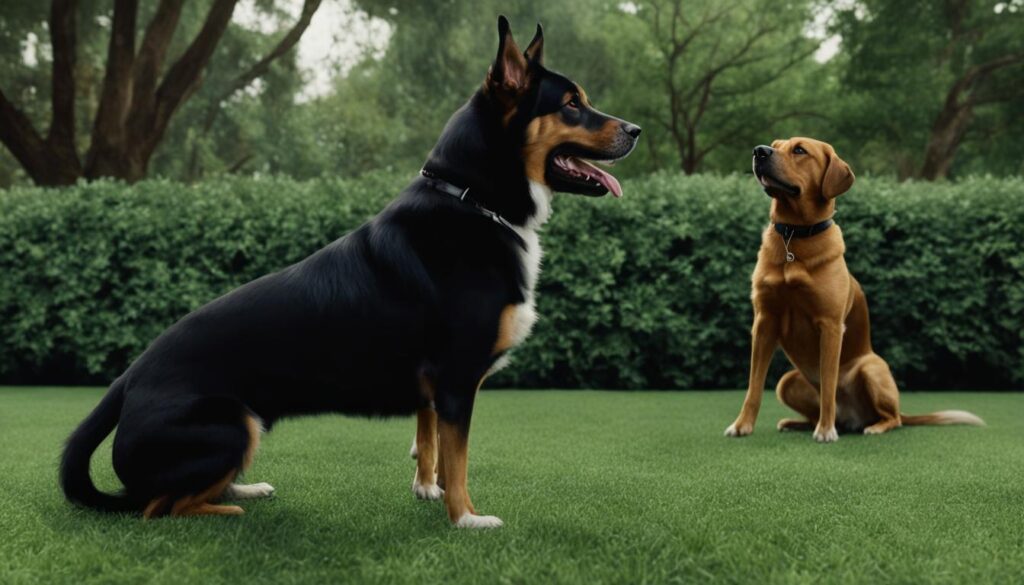Understanding the reproductive cycle of female dogs is essential for responsible dog owners. Knowing when a female dog gets her period, also known as going into heat, allows us to take proper care of our furry friends and make informed decisions about their reproductive health.
Female dogs typically reach sexual maturity around six months of age. This is when they have their first heat or estrus cycle. The duration of a dog’s heat cycle can vary, but it typically lasts about three weeks, ranging from two to four weeks.
During this time, there are several signs that indicate a dog is going into heat. Physically, there may be a swollen vulva and a bloody discharge. Behaviorally, the dog may exhibit changes such as increased urination and receptiveness to male dogs.
It is important to note that dogs’ heat cycles can vary depending on their breed and size. Small dogs tend to go into heat more often, sometimes every four to six months, while large breeds might only experience it once a year.
It is generally recommended to wait until a dog’s third heat before considering breeding. This allows the dog to mature physically and mentally before becoming a mother.
Key Takeaways:
- Female dogs typically get their period, known as going into heat, around six months of age.
- The duration of a dog’s heat cycle can range from two to four weeks, with an average of three weeks.
- Signs of a dog going into heat include a swollen vulva, bloody discharge, increased urination, and receptiveness to male dogs.
- The frequency of a dog’s heat cycles can vary depending on breed and size.
- It is advisable to wait until a dog’s third heat before considering breeding.
How to Manage Your Dog’s “Period”

To effectively manage your dog’s “period” or heat cycle, there are several products available in the market that can provide comfort and prevent messes. Reusable dog diapers, disposable dog diapers, and full-body dog diapers are some of the options you can consider.
Reusable Dog Diapers
Reusable dog diapers are a practical and eco-friendly solution for managing your dog’s heat cycle. These diapers are designed to be absorbent and washable, allowing for multiple uses. They come in different sizes to ensure a secure and comfortable fit for your furry friend.
Disposable Dog Diapers
If convenience is a priority, disposable dog diapers are a great option. These diapers are leak-proof, absorbent, and easy to use. Simply discard them after use, ensuring a hassle-free and hygienic solution for your dog’s heat cycle.
Full-Body Dog Diapers
For added protection and comfort, full-body dog diapers are an excellent choice. These diapers are designed to cover the entire body of your dog, ensuring maximum security and preventing any leakage. They are also antimicrobial, keeping your dog clean and free from any infections during her heat cycle.
Choosing the right type of diaper depends on your dog’s specific needs and your personal preferences. Consider factors such as absorbency, comfort, and ease of use when selecting the appropriate product for your furry friend. With the help of reusable, disposable, or full-body dog diapers, you can effectively manage your dog’s heat cycle while keeping her comfortable and your home clean.
| Type of Dog Diapers | Features |
|---|---|
| Reusable Dog Diapers | – Absorbent – Washable – Available in different sizes |
| Disposable Dog Diapers | – Leak-proof – Absorbent – Convenient |
| Full-Body Dog Diapers | – Secure and comfortable fit – Antimicrobial – Prevent leakage |
When Do Dogs Go Into Heat?

Dogs go into heat every seven months on average. The duration of a dog’s heat cycle can vary between individuals and breeds. It typically lasts for two to three weeks.
During this period, female dogs experience hormonal changes that make them receptive to male dogs for mating. It is important for dog owners to understand the timing of their dog’s heat cycle to ensure proper care and prevent unwanted pregnancies.
Here is a table summarizing the average duration of the heat cycle in different breeds:
| Breed | Duration of Heat Cycle |
|---|---|
| Small Breeds | 2-3 weeks |
| Medium Breeds | 2-3 weeks |
| Large Breeds | 2-3 weeks |
This table shows that the duration of the heat cycle is generally consistent across different breed sizes. However, it is important to note that individual variation can occur, and some dogs may have longer or shorter heat cycles.
It is crucial for dog owners to closely monitor their female dogs during their heat cycle to prevent unplanned pregnancies. This can be achieved through responsible measures such as keeping female dogs indoors, using dog diapers, or separating them from male dogs during the heat cycle.
Phases of a Dog’s Heat Cycle

A dog’s heat cycle consists of three distinct phases: proestrus, estrus, and anestrus. Each phase plays a crucial role in the reproductive cycle of female dogs.
Proestrus:
Proestrus marks the beginning of the heat cycle and lasts for roughly 9-10 days. During this phase, female dogs experience physical changes, including swelling of the vulva and a blood-tinged discharge. These changes serve as indicators that the dog is entering the fertile period of her cycle.
Estrus:
Estrus is the actual heat phase, also known as the “standing heat.” It typically lasts for approximately 5-9 days, but this duration can vary between individuals and breeds. During estrus, the dog is receptive to mating and may exhibit behavior such as flagging her tail to the side, attracting male dogs. It’s important to note that breeding during this phase can result in pregnancy.
Anestrus:
Anestrus is the resting phase of the heat cycle and can last for several months. During this period, the female dog is not in heat and will not display any physical signs. The length of anestrus varies but is influenced by factors such as breed, age, and overall health.
Understanding the different phases of a dog’s heat cycle is important for dog owners who may be considering breeding or managing their dog’s reproductive health. It allows for informed decisions and responsible dog ownership.
Fig. 1: Illustration depicting the phases of a dog’s heat cycle, including proestrus, estrus, and anestrus.
How Do Male Dogs Detect a Female in Heat?

Male dogs have a remarkable ability to detect females in heat through the powerful sense of smell they possess. This enables them to locate females who are ready to mate and initiate the reproductive process.
One of the key factors that male dogs rely on to detect a female in heat is the presence of dog pheromones. These pheromones are chemical substances released by the female’s vaginal and urinary secretions, carrying specific scents that indicate her readiness to mate.
The keen sense of smell possessed by male dogs allows them to detect and analyze these pheromones, even in very small amounts. They can pick up the scent from considerable distances, making it easier for them to locate females in heat.
When a male dog detects the pheromones released by a female in heat, he will often display behaviors such as increased interest, attention, and even restlessness. These behaviors indicate their strong desire to find and mate with the receptive female.
So, the next time you see a male dog intensely sniffing the air or exhibiting unusual behavior, it’s likely that he is detecting the pheromones of a female in heat nearby.
Caption: Male dogs can detect females in heat through their powerful sense of smell.
What Happens When a Dog Goes Into Heat?

When a dog goes into heat, there are several physical and behavioral changes that occur. These changes are normal and are a result of hormonal fluctuations in the dog’s body.
Physical Changes in a Dog in Heat
One of the physical changes that occur when a dog goes into heat is swelling of the vulva. The vulva becomes larger and more prominent than usual. Additionally, there may be a bloody discharge coming from the vulva. This discharge is a normal part of the heat cycle and can vary in color and consistency.
Behavioral Changes in a Dog in Heat
Along with the physical changes, there are also behavioral changes in a dog in heat. These behavioral changes are driven by the dog’s increased fertility and the desire to attract a mate. Some common behavioral changes include:
- Courtship-like behavior: A dog in heat may display behaviors that are similar to courtship, such as licking, nuzzling, and wagging their tail.
- Vocalization: Dogs in heat may vocalize more frequently, whining or howling to attract potential mates.
- Increased activity: Dogs in heat may become more restless and active.
- Increased urination: Female dogs in heat may urinate more frequently, particularly in the presence of male dogs. This is a way of marking their territory and signaling their availability.
It is important to note that not all dogs exhibit the same behaviors during their heat cycle. Some dogs may be more subdued and exhibit fewer noticeable changes, while others may display more pronounced behaviors.
At What Age Do Dogs Go Into Heat?

Dogs can have their first heat as young as 6 months old or as old as 24 months. Small breed dogs tend to have their first heat at an earlier age, while large breed dogs may not go into heat until later.
“It’s important to note that the age at which a dog goes into heat can vary depending on their breed and individual factors. Small breed dogs, such as Chihuahuas or Yorkies, are known to reach sexual maturity earlier and can experience their first heat as young as 6 months old.
On the other hand, large breed dogs like Great Danes or St. Bernards tend to have a slower development, and they may not go into heat until they are around 18 to 24 months old.
Understanding when your dog is likely to go into heat can help you prepare for their reproductive health needs and ensure you take the necessary precautions to prevent unwanted pregnancies.
Do Dogs Go Through Menopause?
Dogs do not go through menopause like humans do. They can continue to go into heat and become pregnant throughout their lives, even into their senior years. However, as dogs age, the frequency and duration of their heat cycles may change.
Unlike humans, dogs do not experience a natural cessation of reproductive capabilities. Female dogs can continue to go into heat and ovulate even in old age. This means that they can still get pregnant, although the chances may be lower compared to when they were younger.
It is important for dog owners to be aware of this fact and take appropriate measures to prevent unwanted pregnancies. This can be done through spaying, which is the most reliable form of birth control for dogs. Spaying involves the removal of the ovaries and/or uterus, eliminating the possibility of pregnancy.
While it is uncommon for dogs to experience complications during pregnancy in old age, it is still advisable to consult with a veterinarian before breeding an older dog. The veterinarian can assess the dog’s overall health and determine if it is safe for her to become pregnant.
It is worth noting that as dogs age, their heat cycles may become less frequent or irregular. This is a natural change that occurs due to hormonal fluctuations. Some dogs may also experience shorter or longer heat cycles. These changes are influenced by factors such as breed, genetics, and overall health.
In conclusion, dogs do not go through menopause, and they can still go into heat and get pregnant throughout their lives. However, as dogs age, their reproductive capabilities may change, and it becomes important for dog owners to take appropriate measures to prevent unwanted pregnancies.
Comparison of Dogs and Humans in Reproductive Life Stages
| Reproductive Life Stage | Humans | Dogs |
|---|---|---|
| Menopause | Occurs in midlife, resulting in the cessation of menstrual cycles and fertility. | Does not occur; dogs can continue to go into heat and get pregnant. |
| Estrus Cycle | Regular monthly cycles (menstruation) in fertile years. | Heat cycles every seven months on average for most dogs. |
| Fertility | Possible until menopause. | Possible throughout a dog’s life, although fertility may decrease with age. |
| Reproductive Procedures | Hormone replacement therapy or assisted reproductive technologies may be used during fertility years. | Spaying is the most reliable form of birth control. |
What to Do When Your Dog Is in Heat
When your dog is in heat, it is essential to take measures to prevent unwanted pregnancies and ensure their well-being. There are various options available to manage the situation and protect your dog during this time.
1. Dog Diapers
Dog diapers are a practical solution to prevent pregnancy and keep your dog clean and comfortable during her heat cycle. These specially designed diapers are available in both reusable and disposable options. Reusable dog diapers are environmentally friendly and cost-effective, while disposable ones offer convenience and easy clean-up.
2. Spaying
The most reliable form of birth control for dogs is spaying. Spaying involves the surgical removal of the ovaries and uterus, ensuring that your dog cannot become pregnant. This procedure not only prevents unwanted pregnancies but also offers other health benefits, such as reducing the risk of certain cancers. It is a permanent solution and should be considered if you do not plan on breeding your dog.
Spaying a dog is the most effective way to prevent unwanted pregnancies and reduce pet overpopulation.
3. Consult with Your Veterinarian
Consulting with your veterinarian is always a good idea when your dog is in heat. They can provide personalized advice based on your dog’s specific needs and circumstances. Your veterinarian can discuss the benefits and risks of spaying and help you make an informed decision.
Remember, preventing pregnancy in dogs is crucial for responsible pet ownership. By using dog diapers and considering spaying as a long-term solution, you can ensure your dog’s well-being and help control the pet population.
| Preventive Measures | Benefits |
|---|---|
| Dog diapers | – Prevent unwanted pregnancies – Keep your dog clean and comfortable |
| Spaying | – Permanent birth control solution – Reduces the risk of certain cancers |
Having Dogs Spayed Is the Most Reliable Form of Dog Birth Control
When it comes to preventing unwanted pregnancies in dogs, spaying is the most effective and reliable method. This procedure involves the surgical removal of a female dog’s ovaries and/or uterus, preventing her from going into heat and reproducing. Spaying is a permanent solution and cannot be reversed.
In addition to birth control, spaying offers several health benefits for dogs. One of the significant advantages is the reduction in the risk of certain types of cancers. Spayed dogs have a significantly lower chance of developing mammary tumors, uterine infections, and ovarian cancers.
During the spaying procedure, the dog is placed under anesthesia, and a qualified veterinarian performs the surgery. It is generally a safe procedure, but as with any surgery, there are certain risks involved. Potential risks of spaying include reactions to anesthesia, bleeding, infection, and complications during the healing process. However, these risks are relatively low, and the benefits of spaying outweigh them.
By opting to spay your dog, you not only prevent unwanted litters but also contribute to reducing pet overpopulation, which is a significant issue worldwide. Spaying is an essential part of responsible dog ownership that helps promote the overall well-being of dogs and reduces the strain on animal shelters and rescue organizations.
It is essential to consult with your veterinarian to discuss the best time to spay your dog. The timing will depend on several factors, such as the breed, size, and overall health of your dog. Your vet will be able to provide personalized recommendations to ensure the procedure is performed at the optimal time.
| Benefits of Spaying Dogs | Risks of Spaying Dogs |
|---|---|
| Prevents unwanted pregnancies | Reactions to anesthesia |
| Reduces the risk of certain cancers | Bleeding |
| – | Infection |
| – | Complications during healing |
As the table illustrates, the benefits of spaying dogs are numerous and well-documented, while the risks associated with the procedure are relatively minimal. Therefore, spaying remains the most recommended method of dog birth control, providing lifelong benefits for your beloved pet.
Wrapping Up
Understanding the heat cycle of female dogs is crucial for responsible dog ownership and maintaining their reproductive health. By being knowledgeable about their dog’s reproductive cycle, pet owners can take the necessary steps to manage their dog’s heat and prevent unwanted pregnancies. This not only ensures the well-being of their pets but also contributes to the overall population control and reduces the strain on animal shelters.
Being aware of the signs and symptoms of a dog in heat, such as swollen vulva and behavioral changes, allows owners to take appropriate measures to minimize any potential issues. Utilizing products like dog diapers can help keep the dog comfortable and prevent messes during their heat cycle.
For a more permanent and effective solution, spaying the dog is highly recommended. Spaying not only prevents unwanted litters but also has numerous health benefits, including the reduction of certain cancers. It is a responsible choice for dog owners who are not planning to breed their pets.
In conclusion, responsible dog ownership entails understanding and managing a female dog’s heat cycle and reproductive health. By being proactive and taking the necessary precautions, dog owners can ensure the well-being of their pets while contributing to the overall welfare of the canine population.
FAQ
When do female dogs get their period?
Female dogs typically reach sexual maturity around six months old and have their first heat or estrus cycle.
How to manage your dog’s "period"?
To manage a dog’s heat, there are several products available such as reusable dog diapers, disposable dog diapers, and full-body dog diapers.
When do dogs go into heat?
Dogs go into heat every seven months on average. The duration of a dog’s heat cycle can vary between individuals and breeds, lasting between two to three weeks.
What are the phases of a dog’s heat cycle?
A dog’s heat cycle is divided into three phases: proestrus, estrus, and anestrus.
How do male dogs detect a female in heat?
Male dogs can detect a female in heat through the pheromones released by the female’s vaginal and urinary secretions.
What happens when a dog goes into heat?
When a dog goes into heat, there are physical changes such as swelling of the vulva, bloody discharge, and changes in the color of the vulva. Behavioral changes include courtship-like behavior, vocalization, increased activity, and increased urination in the presence of male dogs.
At what age do dogs go into heat?
Dogs can have their first heat as young as 6 months old or as old as 24 months. Small breed dogs tend to have their first heat at an earlier age, while large breed dogs may not go into heat until later.
Do dogs go through menopause?
Dogs do not go through menopause like humans do. They can continue to go into heat and become pregnant throughout their lives, even into their senior years. However, as dogs age, the frequency and duration of their heat cycles may change.
What to do when your dog is in heat?
When a dog is in heat, there are measures that can be taken to prevent pregnancy, such as using dog diapers. Spaying a dog is the most reliable form of birth control and can prevent unwanted pregnancies and reduce pet overpopulation.
Having dogs spayed is the most reliable form of dog birth control?
Spaying a dog involves the removal of the ovaries and/or uterus and is the most common and effective method of preventing unwanted pregnancies in dogs. It is a permanent procedure that cannot be reversed. Spaying also has other health benefits for dogs, such as reducing the risk of certain cancers.
Wrapping Up
Understanding the heat cycle of female dogs is an important part of responsible dog ownership. It allows dog owners to effectively manage their dog’s reproductive health and prevent unwanted pregnancies. By being aware of the signs and taking appropriate measures, dog owners can ensure the well-being of their pets.






